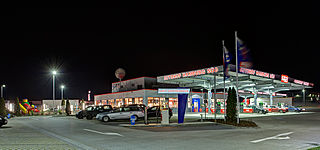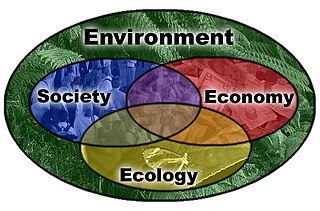Related Research Articles

Transportation engineering or transport engineering is the application of technology and scientific principles to the planning, functional design, operation and management of facilities for any mode of transportation in order to provide for the safe, efficient, rapid, comfortable, convenient, economical, and environmentally compatible movement of people and goods transport.

An intelligent transportation system (ITS) is an advanced application which aims to provide innovative services relating to different modes of transport and traffic management and enable users to be better informed and make safer, more coordinated, and 'smarter' use of transport networks.

Travel behavior is the study of what people do over space, and how people use transport.

A rest area is a public facility located next to a large thoroughfare such as a motorway, expressway, or highway, at which drivers and passengers can rest, eat, or refuel without exiting onto secondary roads. Other names include: motorway service area (UK), services (UK), travel plaza, rest stop, oasis (US), service area, rest and service area (RSA), resto, service plaza, lay-by, and service centre (Canada). Facilities may include park-like areas, fuel stations, public toilets, water fountains, restaurants, and dump and fill stations for caravans / motorhomes.

Carpooling is the sharing of car journeys so that more than one person travels in a car, and prevents the need for others to have to drive to a location themselves.

5-1-1 is a transportation and traffic information telephone hotline in some regions of the United States and Canada. Travelers can dial 511, a three-digit telephone number, on landlines and most mobile phones. The number has also extended to be the default name of many state and provincial transportation department road conditions Web sites, such as Wisconsin's site. It is an example of an N11 code, part of the North American Numbering Plan.

Traffic Message Channel (TMC) is a technology for delivering traffic and travel information to motor vehicle drivers. It is digitally coded using the ALERT C or TPEG protocol into Radio Data System (RDS) carried via conventional FM radio broadcasts. It can also be transmitted on Digital Audio Broadcasting or satellite radio. TMC allows silent delivery of dynamic information suitable for reproduction or display in the user's language without interrupting audio broadcast services. Both public and commercial services are operational in many countries. When data is integrated directly into a navigation system, traffic information can be used in the system's route calculation.

A red light camera is a type of traffic enforcement camera that photographs a vehicle that has entered an intersection after the traffic signal controlling the intersection has turned red. By automatically photographing vehicles that run red lights, the photo is evidence that assists authorities in their enforcement of traffic laws. Generally the camera is triggered when a vehicle enters the intersection after the traffic signal has turned red.
The Integrated Transport Information System (ITIS) is a traffic management system in Klang Valley, Malaysia. The system began operation on 2005 with the cooperation of Kuala Lumpur City Hall (DBKL), Malaysian Highway Authority, Malaysian Public Works Department (JKR) and the Ministry of Transport Malaysia. The system is used for traffic monitoring, accident, construction and other situations that happen on the roads and highways in Kuala Lumpur and Klang Valley. The main ITIS headquarters and traffic operation centre is located at Bukit Jalil Highway near Technology Park Malaysia in Bukit Jalil.
Traffic estimation and prediction systems (TrEPS) have the potential to improve traffic conditions and reduce travel delays by facilitating better utilization of available capacity. These systems exploit currently available and emerging computer, communication, and control technologies to monitor, manage, and control the transportation system. They also provide various levels of traffic information and trip advisory to system users, including many ITS service providers, so that travelers can make timely and informed travel decisions.
Lost time is the term within traffic engineering for the time during which no vehicles are able to pass through an intersection despite the traffic signal displaying a green (go) signal. The total lost time is the sum of two separate elements: start-up lost time and clearance lost time. Start-up lost time happens when a traffic signal changes from red (stop) to green (go). Some amount of time elapses between the signal changing from red to green and the first queued vehicle moving through the intersection. There is then an additional amount of time for the next vehicle to begin moving and pass through the intersection, and so on. The total time taken for all waiting drivers to react and accelerate is the start-up lost time. Clearance lost time is the time lost to stopping a line of vehicles at the end of a green phase. Lost time is always measured in seconds.
Travel technology is the application of Information Technology (IT) or Information and Communications Technology (ICT) in the travel, tourism and hospitality industry. The most prominent examples of travel technology include tourism technology through flight tracking, online travel and tourism agencies, and programs that tourists can review their experiences.
The National Transportation Communications for Intelligent Transportation System Protocol (NTCIP) is a family of standards designed to achieve interoperability and interchangeability between computers and electronic traffic control equipment from different manufacturers.

Wrong-way driving (WWD), also known as counterflow driving, is the act of driving a motor vehicle against the direction of traffic. It can occur on either one- or two-way roads, as well as in parking lots and parking garages, and may be due to driver inattention or impairment, or because of insufficient or confusing road markings or signage, or a driver from a right-hand traffic country being unaccustomed to driving in a left-hand traffic country, and vice versa. People intentionally drive in the wrong direction because they missed an exit, for thrill-seeking, or as a shortcut.
DriveBC is a website and toll-free phone service which provides traffic, road, and weather conditions for British Columbia, Canada’s provincial highways. The service, delivered by the provincial government’s Ministry of Transportation, helps motorists decide when to travel and which route to take.

Computational sustainability is a broad field that attempts to balance societal, economic, and environmental resources using methods from mathematics and computer science fields. Sustainability in this context is the ability to produce enough energy for the world to support its biological systems. Using the power of computers to process large quantities of information, decision making algorithms allocate resources based on real-time information.
PTV AG is a German company specialising in software and consulting services for traffic and transportation, mobility, and logistics. "Vision Traffic Suite", their transport planning software, and "PTV Map&Guide", their program for route planning, comprise the PTV AG's product portfolio. According to the manufacturer, over 2,000 customers in more than 90 countries use the Vision Traffic Suite in the fields of transport modelling and traffic flow calculation. PTV ranks among the top 1,000 global market leaders in Germany according to Germany's Manager Magazin. The German company PTV Planung Transport Verkehr AG is a member of PTV Group.

Smart cities seek to implement information and communication technologies (ICT) to improve the efficiency and sustainability of urban spaces while reducing costs and resource consumption. In the context of surveillance, smart cities monitor citizens through strategically placed sensors around the urban landscape, which collect data regarding many different factors of urban living. From these sensors, data is transmitted, aggregated, and analyzed by governments and other local authorities to extrapolate information about the challenges the city faces in sectors such as crime prevention, traffic management, energy use and waste reduction. This serves to facilitate better urban planning and allows governments to tailor their services to the local population.
Urban traffic modeling and analysis is part of the advanced traffic intelligent management technologies that has become a crucial sector of Traffic management and control. Its main purpose is to predict congestion states of a specific urban transport network and propose improvements in the traffic network. Researches rely on three different informations. Historical and recent information of a traffic network about its density and flow, a model of the transport network infrastructure and algorithms referring to both spatial and temporal dimensions. The final objective is to provide a better optimization of the traffic infrastructure such as traffic lights. Those optimizations should result into a decrease of the travel times, pollution and fuel consumption.

Michel Bierlaire is a Belgian-Swiss applied mathematician specialized in transportation modeling and optimization. He is a professor at EPFL and the head of the Transport and Mobility Laboratory.
References
- ↑ Fatemeh Baratian-Ghorghi; Huaguo Zhou (2015). "Investigating Women's and Men's Propensity to Use Traffic Information in a Developing Country". Transportation in Developing Economies. 1: 11–19. doi: 10.1007/s40890-015-0002-5 .
- ↑ "Advanced Traveller Information Systems(ATIS) | Intelligent Transportation System (ITS)". Intranse.in. 2010-10-27. Archived from the original on 2013-08-23. Retrieved 2013-04-22.
- ↑ Yim, Y. B. (February 1, 2001). "Revenue Models for Advance Traveler Information Systems". California PATH Research Report: 6. Retrieved May 2, 2015.
- ↑ Smartraveller Archived May 3, 2015, at the Wayback Machine - Retrieved 2015-05-02
- ↑ Scan team for 5-1-1- Retrieved 2015-05-03
- ↑ START Archived April 9, 2015, at the Wayback Machine - Retrieved 2015-05-02
- ↑ Intergra-Retrieved 2015-05-02
- ↑ Fatemeh Baratian-Ghorghi; Huaguo Zhou (2015). "Investigating Women's and Men's Propensity to Use Traffic Information in a Developing Country". Transportation in Developing Economies. 1: 11–19. doi: 10.1007/s40890-015-0002-5 .
- ↑ Skoglund, Tor (2014). Effects of long-term access to ICT-mediated travel information services - Users' assessments and reported behavioural changes (PDF). Gothenburg, Sweden: Department of Product and Production Development Division Design & Human Factors Chalmers University of Technology. ISBN 978-91-7597-066-0.